With March 3rd being World Hearing Day, WHO-ITU (World Health Organization and International Telecommunication Union) released a new standard for safe listening devices on February 12th, 2019. As our group researches on improving hearing through array processing, we also think that preventing hearing loss and taking care of our hearing is important. Hearing loss is almost permanent, and there are currently no treatment for restoring hearing once it is lost. In this post, I will revisit the new WHO-ITU standard for safe listening devices, and I will also test how loud my personal audio device is with respect to the new standard.
Summary of WHO-ITU standard for safe listening devices
In the new WHO-ITU standard for safe listening devices, WHO-ITU recommends including the following four functions in audio devices (which is originally found here):
- “Sound allowance” function: software that tracks the level and duration of the user’s exposure to sound as a percentage used of a reference exposure.
- Personalized profile: an individualized listening profile, based on the user’s listening practices, which informs the user of how safely (or not) he or she has been listening and gives cues for action based on this information.
- Volume limiting options: options to limit the volume, including automatic volume reduction and parental volume control.
- General information: information and guidance to users on safe listening practices, both through personal audio devices and for other leisure activities.
Also, as it is written in the Introduction of Safe Listening Devices and Systems, WHO-ITU considers safe level of listening to be listening to sound with loudness under 80dB for a maximum of 40 hours per week. This recommendation is stricter than the standard currently implemented by OSHA (Occupational Safety and Health Administration), which enforces a PEL (permissible exposure limit) of 90dBA* for 8 hours per day with the exposure time halving with each 5dBA* increase in the noise level. NIOSH (The National Institute for Occupational Safety and Health) also has a different set of recommendations concerning noise exposure. They recommend an exposure time of 8 hours for a noise of 85dBA* with the exposure time halving with each 3dBA* increase in the noise level. With this recommendation, workers are recommended to be exposed to noise with 100dBA* for only 15 minutes per day!
Below are the articles that I have referenced, and please read them if you would like to read more concerning safe listening and noise exposure:
New WHO-ITU standard aims to prevent hearing loss among 1.1 billion young people
WHO-ITU standard for safe listening devices
*dBA (A-weighted decibel) is a sound pressure level unit that is different from dB (decibel). I will discuss the differences more in depth in the next section.
Human cannot hear all frequencies equally
Below is an example of a graph called “Equal-loudness contour”. (Originally from Wikipedia)
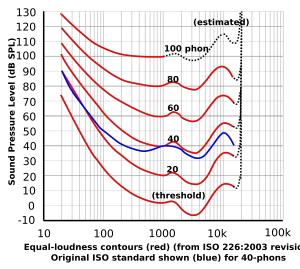
In this graph, the x-axis is the frequency (Hz), the y-axis is the sound pressure level (dB SPL), and each contour corresponds to the loudness (phon) in which human perceive sound across frequencies. To read this graph, for example, we can see that human perceives both a 1000Hz sound at 60dB SPL and a 200Hz sound at 70dB SPL as a sound with loudness of 60phon. As seen from this graph, even if sounds are present in an environment at the same sound pressure level, human perceives low frequency sounds quieter than mid frequency sounds. Also from the graph, it can be seen that the difference of loudness between mid frequency sounds and low frequency sounds increases as the loudness decreases. In other words, the difference of loudness between mid frequency sounds and low frequency sounds at 60dB SPL is greater than the difference between mid frequency sounds and low frequency sounds at 100dB SPL. This might be why young people tend to listen to music at loud volume since they like to hear “the bass” in their music.
“A-weighted decibel”, which was marked with an asterisk in the previous section, relates to the fact that human perceives mid frequency sounds louder than low frequency sounds. “A-weighted decibel” tries to account for, although not accurate, how human perceives different frequencies, so it is configured to emphasize the mid-frequency regions more than the standard decibel unit. If you would like to learn more about “A-weighted decibel”, I recommend reading What is A-weighting?.
How do 80dB and 100dB sound like?
Until this point, I have summarized the new standard, which was issued by WHO-ITU, and went over how human perceives sound at different frequencies. However, it is hard to get an idea of what 80dB and 100dB sounds sound like. On the internet, there are resources, such as Noise Levels Chart and YouTube videos with white noise and sine waves at certain loudness, but those resources are still hard to understand. They are also too reliant on the listeners’ experience and environments, so we can hardly call those resources dependable and accurate. Also, Apple and other audio device makers tend to not publish their audio device’s specification with regard to loudness, so it is hard to gauge how loud our personal audio device is playing. In order to see how loud audio devices can be playing audio, I conducted a crude experiment, which I hope will be helpful to you as well!
Preparing the experiment
In this experiment, I used a chunk of styrofoam, IPod Touch, earphones, and a decibel meter. In order to mimic the ear canal, I drilled a hole with a diameter of about 0.7cm through the styrofoam so that the distance between the earphone and the tip of the decibel meter was around 2.5cm. I used Betron ELR50 in the initial experiment with earphones, and later, I used V-moda Crossfade in the experiment with headphones. The decibel meter measured sound in A-weighted decibel unit, and it mentioned that it can measure accurately between 30dBA and 130dBA. The IPod Touch that I used is a 7th generation IPod Touch, and I have not set a volume limiter. In the experiment, I tested at three different slider placement: slider at slightly less than the halfway point, slider at around 80%, and slider at 100%. Finally, the audio source that I used in the experiment is this. By using an actual music in this experiment, I thought it is more relatable to how we normally use our audio devices. Also, the music used in this experiment is free to download, so you could conduct your own test as well if you would like to!
Below is a picture of the test setup:
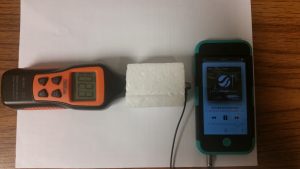
Slider at little less than the halfway point with earphones
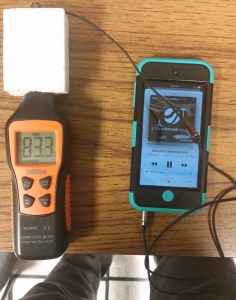
It should be possible to check the position of the slider from the picture. With this slider position, it was seen that the loudness of the audio fluctuated between 74dBA and 86dBA. Even with this slider position, it is slightly surpassing safe listening level issued by the new WHO-ITU standard.
Slider at around 80% with earphones
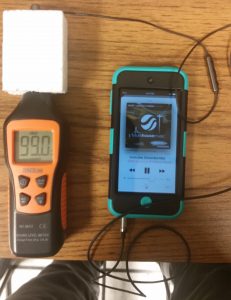
Now, the slider position is moved to the 80% position. With this slider position, it was seen that the loudness of the audio fluctuated between 89dBA and 106dBA. This volume is above the new standard by quite a bit. Note that since decibel is a log scale unit, even the difference of 10dBA can be significant.
Slider at 100% with earphones
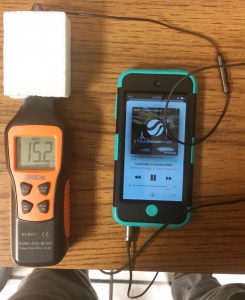
This is the last experiment with earphones, where the slider is moved to the max volume position. While testing, I was able to hear the music even without earphones directly in my ear. With this slider position, it was seen that the loudness of the audio fluctuated between 102dBA and 118dBA. Considering that the threshold of pain, or the sound pressure level in which human starts to feel pain from a sound source, is 120dB, seeing that max volume of an IPod Touch can emit volume close the threshold is frightening.
Slider at little less than the halfway point with headphones
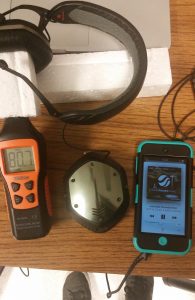
Next, we did the same experiments with headphones. Since the block of styrofoam did not fill the cup of the headphone, some sound was heard leaking from the headphones. Also since the vibration from the headphones were significant, another block of styrofoam was placed underneath the headphones in order to minimize noise from vibrations. Anyways, with the slider at slight less than the halfway point, the audio fluctuated between 66dBA and 82dBA.
Slider at around 80% with headphones
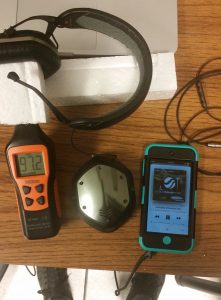
Now, the slider position is moved to the 80% position. With this slider position, it was seen that the loudness of the audio fluctuated between 89dBA and 95dBA.
Slider at 100% with headphones
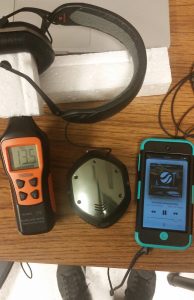
Lastly, the slider position is moved to the max volume position. With this slider position, it was seen that the loudness of the audio fluctuated between 98dBA and 114dBA.
Conclusion of the crude experiment
As seen from the above results, the loudness from the audio device exceeded the new WHO-ITU standard even when the slider was positioned at slightly less than the halfway point. I have seen some articles recommending the slider to be at 80% for safe listening, but the volume at 80% position was well above the safe listening levels.
Important thing to note concerning this experiment is that this experiment was conducted as a reference. Many variables, such as the audio file that the user is listening to, the audio device that the user is using, could affect the slider differently from the way it was represented in this experiment. For example, when I tested with an another audio file, it seemed to increase the loudness by a little: maximum of 88dBA was seen when the slider was at slightly less than the halfway point, maximum of 105dBA was seen when the slider was at 80% position, and maximum of 119dBA was seen when the slider was at the max volume position.
Noise-cancelling headphones are not perfect either…
So far, we have discussed the new WHO-ITU standard and how it compares to sound emitted from audio devices today. However, we have not mentioned any concrete ways in which people could prevent hearing damage and hearing loss.
When searching around the internet, noise-cancelling headphones are advertised as a popular method to take care of hearing. Personally, although I do not have enough information to back my claim, I do not think that noise-cancelling headphones can be seen as a solution to hearing care. Noise-cancelling headphones do help decrease the volume of the audio getting emitted into the ear since they decrease background noise, but human ears are not accustomed to complete or near silence. Since people are not accustomed to such environment, people are prone to become more sensitive to daily noise when they take off their noise-cancelling headphones, which could cause tinnitus.
My personal tip to take care of hearing is to 1. don’t listen continuously and 2. stay away from earphones and earbuds. Giving ears a time to rest is important as other parts of our body. Furthermore, I recommend using speakers or headphones when listening to audio files since the distance between the sound source and the ear is further apart. As the distance between the sound source and the ear becomes further, energy from sound gets dispersed, which can reduce the pressure applied on the ear.

